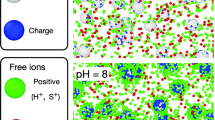Abstract
The Brownian dynamics method is employed to study the formation of an electrical double layer (EDL) on the metal nanoparticle (NP) surface in hydrosols during adsorption of electrolyte ions from the interparticle medium. Also studied is the charge accumulation by NPs in the Stern layer. To simulate the process of the formation of EDL, we took into account the effect of image forces and specific adsorption, dissipative and random forces, and the degree of hydration of adsorbed ions on the EDL structure. The employed model makes it possible to determine the charge of NPs and the structure of EDL. For the first time, the charge of both the diffuse part of EDL and the dense Stern layer has been determined. A decrease in the electrolyte concentration (below c < 0.1 mol/l) has been found to result in dramatic changes in the formation of the Stern layer.

Graphical abstract





Similar content being viewed by others
References
Rao C. N. R., Müller A, Cheetham AK (eds) (2004) The chemistry of nanomaterials. Wiley-VCH Verlag GmbH & Co. KGaA, Weinheim
Sonntag H, Strenge K (1970) Koagulation und stabilität disperser Systeme, 173 S., VEB Deutscher Verlag der Wissenschaften, vol 73. Preis: 30.80 MDN, Berlin, p 1971
French RH, Parsegian VA, Podgornik R, Rajter RF, Jagota A, Luo J, Asthagiri D, Chaudhury MK, Chiang Y-M, Granick S, Kalinin S, Kardar M, Kjellander R, Langreth DC, Lewis J, Lustig S, Wesolowski D, Wettlaufer JS, Ching W-Y, Finnis M, Houlihan F, von Lilienfeld OA, van Oss CJ, Zemb T (2010) Long range interactions in nanoscale science. Rev Modern Phys 82:1887–1944,6
Walker DA, Kowalczyk B, de la Cruz MO, Grzybowski BA (2011) Electrostatics at the nanoscale. Nanoscale 3(4):1316
Linse P (2005) Simulation of charged colloids in solution
Henderson D, Boda D (2009) Insights from theory and simulation on the electrical double layer. Phys Chem Chem Phys 11:3822, 4
Spohr E (1999) Molecular simulation of the electrochemical double layer. Electrochim Acta 44:1697–1705, 1
Semashko OV, Brodskaya EN, Us’yarov OG (2005) Molecular dynamics simulation of the electrical double layer of spherical macroion. Colloid J 67:625–630, 9
Fahrenberger F, Xu Z, Holm C (2014) Simulation of electric double layers around charged colloids in aqueous solution of variable permittivity. J Chem Phys 141:064902, 8
Messina R, Holm C, Kremer K (2001) Effect of colloidal charge discretization in the primitive model. Eur Phys J E 4:363–370, 3
Gan Z, Xing X, Xu Z (2012) Effects of image charges, interfacial charge discreteness, and surface roughness on the zeta potential of spherical electric double layers. J Chem Phys 137:169901, 10
Torrie GM, Valleau JP, Patey GN (1982) Electrical double layers. II. Monte Carlo and HNC studies of image effects. J Chem Phys 76:4615–4622, 5
Emelyanenko KA, Emelyanenko AM, Boinovich L (2015) Image-charge forces in thin interlayers due to surface charges in electrolyte. Phys Rev E 91:032402, 3
Izraelashvili JN (2011) Intermolecular and surface forces. Elsevier, Amsterdam
Campo MG, Raul Grigera J (2004) Molecular dynamics simulation of OH - in water. Mol Simul 30:537–542, 7
Botti A, Bruni F, Imberti S, Ricci MA, Soper AK (2003) Solvation of hydroxyl ions in water. J Chem Phys 119:5001–5004, 9
Heermann DW (1990) Computer simulation methods in theoretical physics. Springer, Berlin
Tuckerman ME, Chandra A, Marx D (2006) Structure and dynamics of OH - (aq). Account Chem Res 39:151–158, 2
Tuckerman ME, Marx D, Parrinello M (2002) The nature and transport mechanism of hydrated hydroxide ions in aqueous solution. Nature 417:925–929, 6
Patrito E, Paredes-Olivera P (2003) Adsorption of hydrated hydroxide and hydronium ions on Ag(111). A quantum mechanical investigation. Surf Sci 527:149–162, 3
Nechaev IV, Vvedenskii AV (2009) Quantum chemical modeling of hydroxide ion adsorption on group IB metals from aqueous solutions. Protect Met Phys Chem Surf 45:391–397, 7
Bunkin NF, Bunkin FV (2003) Screening of strongly charged macroparticles in liquid electrolyte solutions. J Exper Theor Phys 96:730–746, 4
Mateescu EM, Jeppesen C, Pincus P (1999) Overcharging of a spherical macroion by an oppositely charged polyelectrolyte. Europhys Lett (EPL) 46:493–498, 5
Park SY, Bruinsma RF, Gelbart WM (1999) Spontaneous overcharging of macro-ion complexes. Europhys Lett (EPL) 46:454–460, 5
Joanny J (1999) Polyelectrolyte adsorption and charge inversion. Eur Phys J B 9:117–122, 5
Funding
The reported research was funded by the Russian Foundation for Basic Research and the government of the Krasnoyarsk territory, Krasnoyarsk Regional Fund of Science, grant No 18-42-243023, the RF Ministry of Education and Science, the State contract with Siberian Federal University for scientific research in 2017–2019.
Author information
Authors and Affiliations
Corresponding author
Ethics declarations
Conflict of interests
The authors confirm that there are no known conflicts of interest associated with this publication.
Additional information
Publisher’s note
Springer Nature remains neutral with regard to jurisdictional claims in published maps and institutional affiliations.
Rights and permissions
About this article
Cite this article
Gavrilyuk, A.P., Isaev, I.L., Gerasimov, V.S. et al. Physical principles of the formation of a nanoparticle electric double layer in metal hydrosols. Colloid Polym Sci 298, 1–7 (2020). https://doi.org/10.1007/s00396-019-04573-8
Received:
Revised:
Accepted:
Published:
Issue Date:
DOI: https://doi.org/10.1007/s00396-019-04573-8




